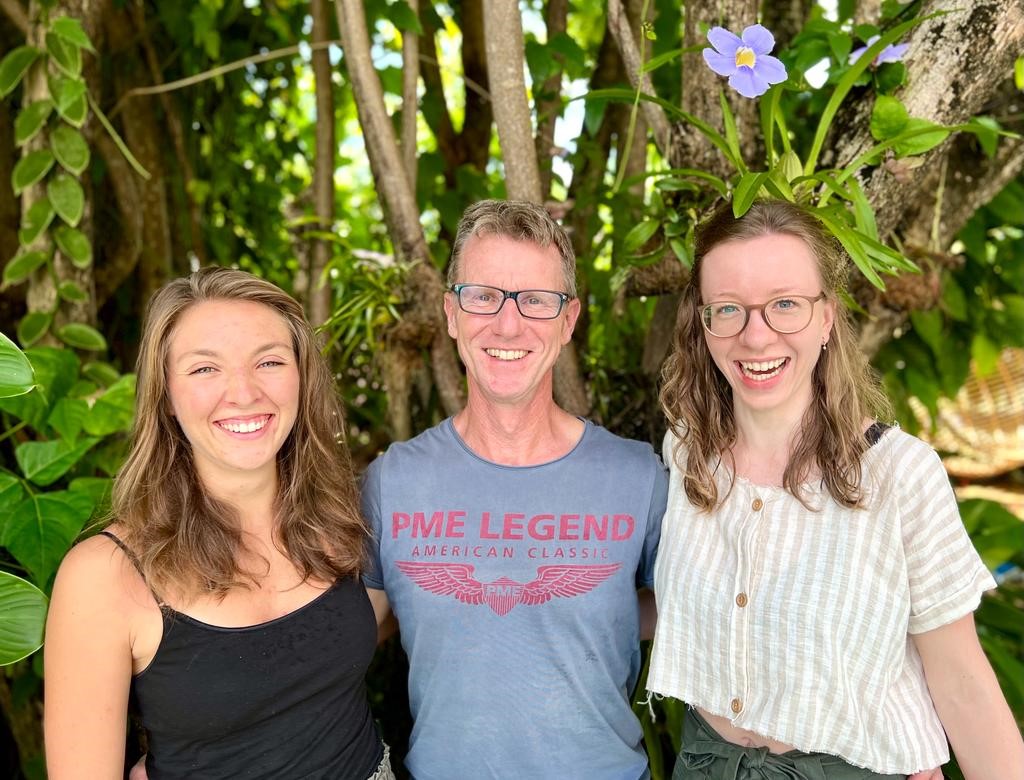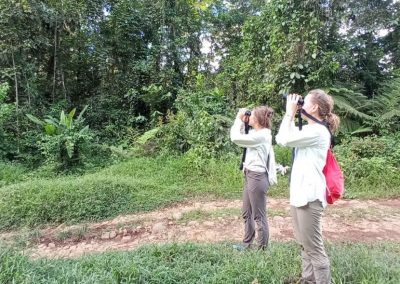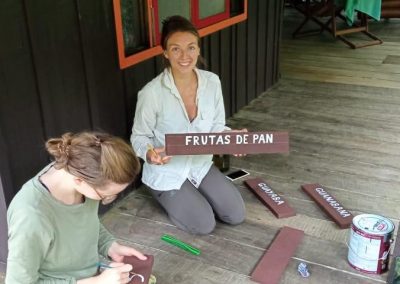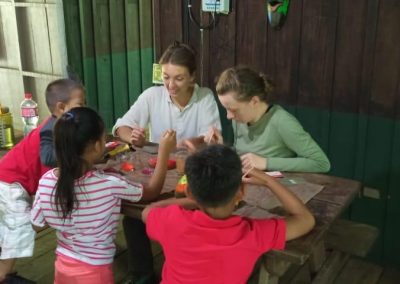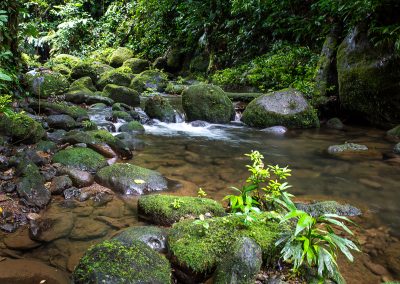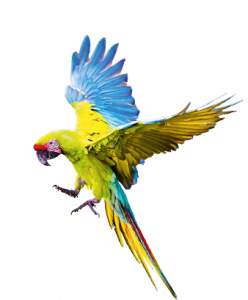In search of the macaws
Would you like to know more about volunteering at Tropica Verde? Then you’ve come to the right place!
In our interview, the two volunteers Bastienne Dünbier and Freya Wenzel talk about their first-hand experiences after volunteering in the Tropica Verde (TV) projects “Reserva Kinkajou” and “Monte Alto”.
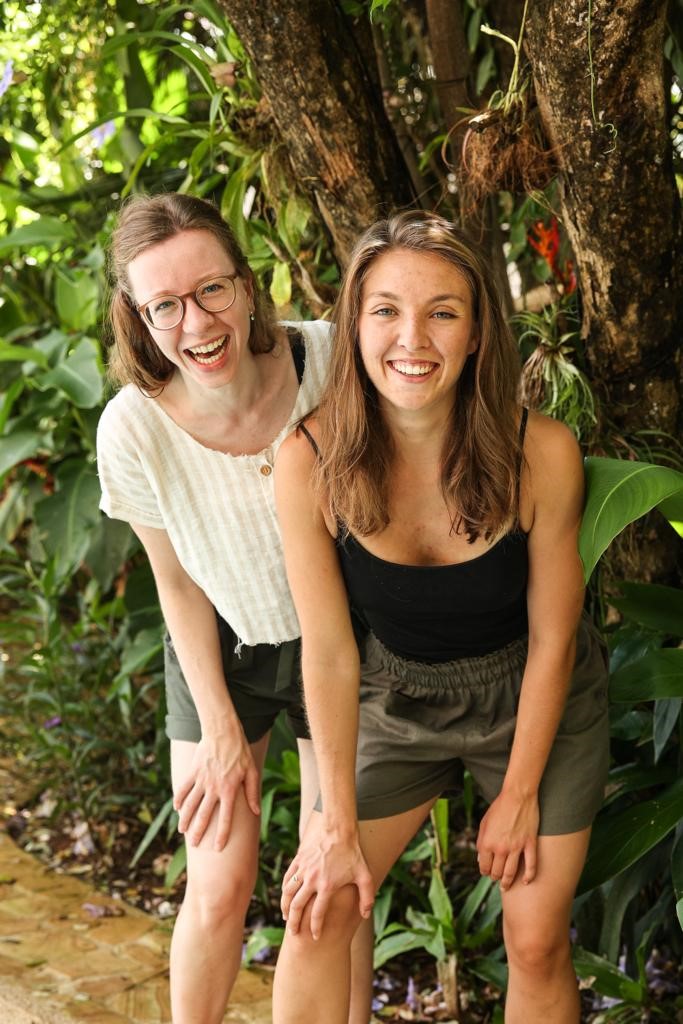
Hi Bastienne & Freya, you did an internship in 2 Tropica Verde projects in November 2022. How did this come about?
We had just finished our studies and were keen to think outside the box again, preferably in the form of meaningful project work. We both grew up very close to nature and the environment is close to our hearts. Freya’s mother works as a forester in Hesse. We came across Tropica Verde through a friend of ours who also works in nature conservation and simply gave them a call. A very friendly member of staff put us in touch with Stefan Rother, who is responsible for the project, and recommended that we send him an email with our request to participate in current projects to protect the rainforest. Stefan contacted us immediately and did his utmost to involve us in two different projects of the organization for a month. After a few phone calls and video calls, we knew that we would be spending a month in the middle of the jungle during our trip to South America. We would like to take this opportunity to thank Stefan Rother once again. Without his commitment, this unique experience would not have been possible.
What project did you start with and what were your expectations?
We first visited the Reserva Kinkajou. This area for the protection of the Great Soldier Macaw borders the Braulio Carrillo National Park. We knew that our accommodation, the Yatama Ecolodge, which is right next to the Reserva Kinkajou, would be very difficult to reach. That’s why we envisioned the project to be very secluded and original. That was true until we learned to distinguish between primary and secondary forest in the rainforest. If you only know German forests, it’s not that easy at first. With all the reforestation areas and secondary forest around us, we realized that perhaps there is less originality than we thought. This does not detract from its beauty, but is of course part of a sad history. Before the project started, we didn’t know exactly what tasks and what kind of project we would be faced with, so we set off into the countryside with curiosity.
“So it all began very adventurously…”
What were your impressions of the Reserva Kinkajou? From access to reforestation and nature, as well as partnership with the Yatama Lodge. Tell us everything!
On the morning of our arrival, we were a little nervous about what to expect in the deepest jungle. To reach the Reserva Kinkajou and our accommodation, the Yatama Ecolodge, you drive for just under an hour in a pickup truck along an unpaved road with wonderful views. So it all began very adventurously and after the first night walk at the latest, we were under the spell of the jungle and hoped to be able to observe new animal species every day. One of our tasks was the morning and evening count of the Great Soldier Macaw, where we were very kindly looked after by Pedro, the owner of the Yatama Ecolodge and partner of Tropica Verde. Thanks to him, we learned a lot about the rainforest and its inhabitants during the two weeks. As Tropica Verde has reforested the Reserva Kinkajou with a rich variety of species, you can observe and listen to many different bird species. It is a dream place for nature lovers and the feeling of living in the middle of the rainforest, with all its smells, is indescribable. Even before our trip, we considered the protection of the rainforest and its inhabitants to be a very important issue. However, seeing the monkeys swinging from tree to tree while the toucan sits in the tree next to them and the Oropendola bird trills its unique melody feels even more different. It makes you realize that we should protect this wondrous world as best we can. For this reason, the existence of organizations like Tropica Verde is essential to stop the extinction of species and the reduction of forest areas.
What did you like best there? What do you think are the options there for the future?
The most impressive thing was to see and feel the incredible diversity of nature, which is so colorful and unknown that such an experience makes an incredible impression on you. At first you notice that you don’t have an eye for the well-adapted animals and often enough walk past them without a second thought. It was great fun to learn this thanks to many inspiring people and to memorize the foreign tree species and animal names. In Germany, too, we consider the forest to be incredibly worthy of protection, but the rainforest cries out louder, shriller and more colourful for help and therefore possibly holds great potential to win over less nature-loving people for its protection. We have heard that Tropica Verde is considering setting up an environmental education room in the hut at Reserva Kinkajou. Ideas like this are great because they allow locals to use these spaces and get the younger generations on board. We met many locals our age in Costa Rica who are very committed to protecting the environment and we need to support them.
How did you get from the rainforest in Sarapiqui to Guanacaste to the Monte Alto dry forest project?
After a somewhat sad farewell to Pedro and his colleague Luis, with whom we had become friends during our two weeks at the Yatama Ecolodge, we boarded the bus to make our way to Monte Alto. You have to change trains in the capital San José. After a stopover in Nicoya, we arrived at the Reserva Natural Monte Alto the next day, where the staff welcomed us with open arms. On our bus trip across the country, we were already able to observe the change in flora and fauna.
How were you accommodated in Monte Alto and how did you look after yourselves on site?
We stayed in a cute little wooden house in Monte Alto, which was free due to the low season, as Monte Alto is often visited by groups who want to train there. As before the first project, we did a lot of shopping before the project started, as we didn’t know how often we would be coming to the village. This was a small misunderstanding, because in the end we were cooked for every day, which of course would not have been necessary. For special requests and to explore the area, we were able to use two mountain bikes from Tropica Verde and ride to the nearby village of Hojancha. This allows a lot of flexibility, but is not for the lazy, as the gradient should not be underestimated (especially if you then accidentally ride up the wrong hill, which of course happened to us specialists).
What did you learn in Monte Alto? What were your impressions of the surroundings?
The Reserva Monte Alto is located in the middle of idyllic hills and meadows with some pastures near the village of Hojancha. The region is remote from the more touristy towns, so you can get an impression of the life of the Ticos as well as walking through the dry forest. This is very important to us when traveling, to experience how the culture and people of the country are shaped.
Thanks to the friendly support of local Tropica Verde employee Gustavo Moraga, we learned a lot about wildlife observation methods in Monte Alto. This included the use of wildlife cameras, setting up game traps to secure evidence of various animal species using a casting process and catching birds to identify species in a region. We also learned a lot about the relevance of wildlife corridors in the context of species protection and about the effects of the fragmentation of land through road construction and deforestation. Here, too, you quickly realize the serious consequences that human intervention in nature can have. In this context, it was particularly nice to travel to a school to encourage the children to work on projects and to teach them about the environment, and in Monte Alto we also took on various maintenance tasks, as the buildings there require regular care due to the severe weather conditions.
What costs did you have to bear yourself?
Our volunteering should of course be completely independent of the donations the organization receives. It was therefore a matter of course to take care of the arrival and departure independently. We also paid a daily rate of the equivalent of 35 euros to our hosts. In Monte Alto, full catering was included in this price. At the Yatama Ecolodge, Pedro provided us with basic foodstuffs and we bought the rest. But that’s not a lot of money and we were sometimes allowed to harvest breadfruit or coconuts to supplement our diet in Kinkajou.
“It’s quite possible that the gecko will accompany you to the toilet…”
What advice would you give to other interested volunteers regarding preparation and stay?
You should be prepared to live in the rainforest with lots of animals and insects, so it is quite possible that a gecko will accompany you to the toilet or a toad will stray onto the veranda in the evening. But that’s not too tragic and you gradually get used to it. Pedro knows his way around the Reserva Kinkajou, which is home to some very poisonous snakes and other exotic animals. If you follow his “safety instructions” and tips and pay close attention to your surroundings when out walking, you are on the safe side.
Long, loose clothing is recommended and rubber boots, if there is room for them in your luggage. Especially if you enjoy trudging through the jungle, there really is no more suitable footwear than good rubber boots. On rainy days, it can happen that you sink almost knee-deep in mud. Especially when staying at the Yatama Ecolodge, it is also advisable not to have your favorite pieces in your luggage. With the high humidity, drying laundry is an almost hopeless case, especially in the rainy season, and items that you didn’t even know were capable of it start to mold…after the two weeks, we know what we’re talking about. It may be that some of the stains cannot be removed or that bleaching with chlorine is the only remaining option. Overall, however, we can say that the small mishaps are definitely worth the experience and that we can definitely overlook a few stains on the floor with such unique moments that we were able to experience.
A basic knowledge of Spanish is also highly recommended. Pedro speaks very good English at Reserva Kinkajou, but the other staff do not. Otherwise, it is worth discussing your skills with Tropica Verde, because then the project partners can use you in a variety of ways on site and you can also be used as an English teacher in no time at all.
If there were any uncertainties or questions, there was always someone we could turn to throughout the project. In any case, we can give huge praise to the support team!
And…take heart! We are also non-specialists and have not studied biology. Nevertheless, everyone can contribute to protecting the environment – after all, it affects us all. We diligently share our experiences and hope to sensitize our fellow human beings as best we can.
Thank you very much for the interview, dear Bastienne and Freya. We at Tropica Verde would like to thank you for your cooperation and commitment and wish you all the best and every success on your future journey!
